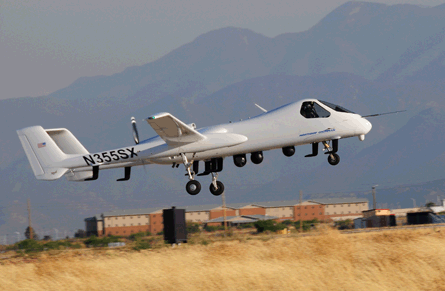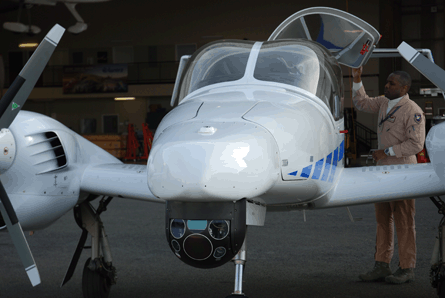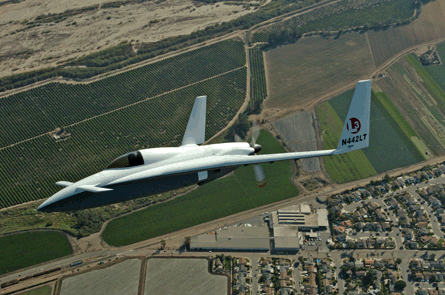Unmanned aircraft are almost as old as aviation itself, but with technological innovations that allow for secure links beyond line-of-sight, the difficulties in reliably guiding and communicating with the aircraft have eased significantly.
Unmanned aerial vehicles (UAVs) are rapidly becoming a ubiquitous part of warfare, present in virtually every conflict, ful-filling roles that range from helping small units peer over a hill to overall strategic reconnaissance.
Seemingly every week a new UAV appears to fill a tactical or political niche. Virtually all UAVs now promise both remote piloting and fully autonomous capabilities.
 |
|---|
© Northrop GrummanNorthrop Grumman's Firebird does not readily slot into any defined capability requirements |
Bypassed in the race to autonomy has been what was imagined by many as a bridge capability - the optionally piloted vehicle (OPV), designed to fly both with a pilot on board or without. But now OPVs are becoming more popular, as planners learn the benefits of having the versatility of a UAV and the wisdom of a human pilot.
There are at least 26 models of OPV flying today, most of which are still in testing, and many of which are technology demonstrators or testbeds.
A NICHE ROLE
OPVs fill a niche role; they must be large enough to haul a pilot and a useful payload while piloted, but provide the endurance expected of a similarly-sized UAV when unmanned. Most similar UAVs are medium-altitude long-endurance (MALE) models - and so too are the OPVs.
As with most of their unmanned counterparts, OPVs to date have been exclusively propeller-driven aircraft, built to fly at low speeds and loiter for extended periods of time.
MALE aircraft tend to carry the greatest range of payloads - and OPVs so far do the same.
The notable exception is munitions, which are frequently carried and employed by MALE UAVs, while OPVs, for now, remain limited to the intelligence, surveillance and reconnaissance (ISR) role.
The OPV field is dominated by aircraft modified from manned platforms - aircraft like the Austrian-built Diamond DA-42, a twin-engine aircraft commonly flown by general aviators and flight schools, or the Berkut, a home-built descendent of the Rutan Long EZ, both of which have long range and a large potential payload capacity.
Other airframes modified to act as OPV, including the Tecnam P-92 and Stemme S-10 motor glider, have similar properties.
 |
|---|
© Aurora Flight Sciences |
The only purpose-built exception thus far is the Northrop Grumman Firebird - built by Northrop's scaled composites division as an OPV. The Firebird is also the industry's newest entry, having first flown in February 2011.
However, there are still significant barriers facing the development of OPVs - chief among them a limited, albeit growing, market.
Major UAV operators have their needs fulfilled by relatively new aircraft, and simply have no pressing requirement to replace mature, fully functional ISR platforms. But as in-service UAVs age, and OPV technology matures, the opportunity for OPVs to enter the market increases. "I think the basics are that a capability that allows you to operate manned and unmanned is a functionally differentiated capability," says Tom Clancy, chief technology officer and vice president of advanced concepts at US-based Aurora Flight Sciences.
"It's useful to have a person on board; people can do some pretty specific things, in terms of judgements."
NARROW FIELD OF VISION
Pilots flying remotely from the ground are forced to fly with a narrow field of vision, unable to react to or even detect outside stimuli.
Anti-aircraft fire, for example, may go undetected, unless either the pilot's nose camera or sensor operator's turret is already pointed at the attacker.
The same need for a human pilot applies during landing, when small variations in weather, airports and runways can make the act very difficult.
Current standard practice is for the commanding pilot, controlling via satellite from anywhere in the world, to hand off to a locally-based pilot flying by line-of-sight data link.
The airport and approach must be scanned beforehand, and programmed into the UAV's memory.
Perhaps the strongest case for buying an OPV is that UAVs cannot operate in public airspace.
Despite a decade of large-scale UAV operations by the US military, UAV flights through US civil airspace can require months of co-ordination, and a variety of clearances from the Federal Aviation Authority. As a major player, the American defence establishment's buying power distorts the market in such a way that much equipment is built with one eye on the US market. This trend is particularly strong in UAVs, which have become integral to everyday American combat operations.
Despite having no requirements for MALE OPVs, several are operated by the military for testing and training, and manufacturers are keen to jump at the opportunity to sell more.
 |
|---|
© L-3L-3's Mobius has a ceiling of 27,000ft |
This is not to say that planners are ignoring OPVs - there are big plans on the horizon.
The US air force's Next Generation Bomber - a large, stealthy, nuclear-capable aircraft - will likely be optionally piloted, and well outside the realm of MALE UAVs. The US army is planning to convert almost all of its massive helicopter fleet to OPV control schemes. "Over the next 25 years, the [US] Army aviation shifts from being almost entirely manned to consisting of mostly unmanned and OPV," states the army's aviation planning document - the so-called roadmap.
The idea is to keep helicopters flying beyond the crew duty time - limited to eight hours - so that their capabilities will be limited only by the machine's endurance.
In preparation for the shift, the army has launched the manned/unmanned resupply aerial lifter (MURAL) program, consisting of two UH-60 Blackhawks modified by Sikorsky as demonstrators.
The aircraft will be put through their paces at an exercise scheduled in autumn.
FIREBIRD'S CAPABILITIES
Though the aircraft was designed with the US military in mind, Northrop Grumman's Firebird does not readily slot into any defined capability requirements.
The lone Firebird airframe has flown about 350 hours in testing and demonstrations, including during the US Army's annual Empire Challenge exercise, and Northrop Grumman has consistently announced its satisfaction with the results to date.
By demonstrating the Firebird's capabilities, Northrop hopes to "change the buying habits" of the US Army. Despite having no plans to include the requirement, the massive Predator replacement programme - MQ-X - appears ill-defined enough that OPV manufacturers can justifiably position themselves for a bid. The Firebird itself has weapon hardpoints, in addition to its intelligence payloads.
"Our focus is based on a premise that there is - and will be - a continuing and growing need for ISR," says Rick Crooks, Firebird programme manager. "If you look at the army's roadmap, you look at the air force flight plan, the OSD [Office of the Secretary of Defence] roadmap, there's no decline in unmanned vehicles or even manned assets to perform the unmanned mission."
The US will account for roughly 69% of the total world UAV market over the next decade, according to a report released in march from aerospace industry analysts Teal Group. The market is predicted to encapsulate a value of roughly $65 billion (€46 billion).
"In terms of what markets or missions does it enable, it's really a broad market segment," says Clancy. "That is to say, DoD [Department of Defence] missions, DHS [Department of Homeland Security] missions, law enforcement missions."
Aurora is in negotiations for "tens of aircraft", ranging across the spectrum of governments.
Northrop reports similar interest. "We're doing periodic tours and presentations from a variety of customers," says Crooks. "The phone is ringing."
- Could the mysterious Super Talon be Northrop Grumman's next surprise?
Source: Flight International























